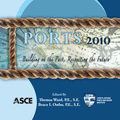Physical Model Tests of Bowthruster Impacts to Armored Slopes
Publication: Ports 2010: Building on the Past, Respecting the Future
Abstract
Protection of revetments under wharves against scour related to bowthrusters is becoming increasingly important and more difficult to achieve as the container vessels become larger with each new class of vessel. The associated larger and more powerful bowthrusters increase the potential for damage to the armor protecting the slope. Existing analytical techniques for armor requirements are limited when addressing the impacts associated with this larger generation of bowthrusters. The primary focus of this study was to evaluate revetment armor stability related to the latest generation of bowthrusters. This was accomplished using a relatively large scale physical model of both single and dual bowthruster configurations at various elevations and distances to the armored slope. Two armor sizes and two slope angles were tested. Several significant observations were made during the model test program. The most significant result was the higher velocities of the bowthruster-induced jet with distance from the vessel hull was more than suggested in the literature. An additional significant result was the flow field resulting from dual bowthrusters. Based on detailed velocity profiles it is apparent that dual bowthruster velocity fields tend to remain generally separate for each thruster in terms of the maximum velocities, at least over the distances tested. This leads to substantially smaller velocities for dual thrusters than would be predicted with superposition of the velocity fields as suggested in the literature. The model test results suggest that the armor stone stability should be based on essentially no movement of the armor stone. This conclusion was based on the results of tests where bursts from the thrusters were repeated many times. These tests resulted in progressive cumulative damage once there was any movement to the armor stone at a given velocity. This suggests a lower velocity threshold than would typically be used in other areas of a port where damage repair is easier and damaging events are more random, thereby allowing a damage risk factor to be used in sizing the armor. This lower velocity threshold resulted in somewhat higher stability coefficients when compared to suggested values.
Get full access to this article
View all available purchase options and get full access to this chapter.
Information & Authors
Information
Published In
Copyright
© 2010 American Society of Civil Engineers.
History
Published online: Apr 26, 2012
ASCE Technical Topics:
- Armor units
- Coastal engineering
- Coasts, oceans, ports, and waterways engineering
- Continuum mechanics
- Dynamics (solid mechanics)
- Engineering fundamentals
- Engineering mechanics
- Flow (fluid dynamics)
- Fluid dynamics
- Fluid mechanics
- Fluid velocity
- Forces (type)
- Geology
- Geomechanics
- Geotechnical engineering
- Hydraulic engineering
- Hydraulic structures
- Hydrologic engineering
- Impact tests
- Laboratory tests
- Models (by type)
- Physical models
- Revetments
- Riprap
- Rocks
- Shores
- Slopes
- Solid mechanics
- Tests (by type)
- Thrust
- Velocity profile
- Water and water resources
Authors
Metrics & Citations
Metrics
Citations
Download citation
If you have the appropriate software installed, you can download article citation data to the citation manager of your choice. Simply select your manager software from the list below and click Download.
